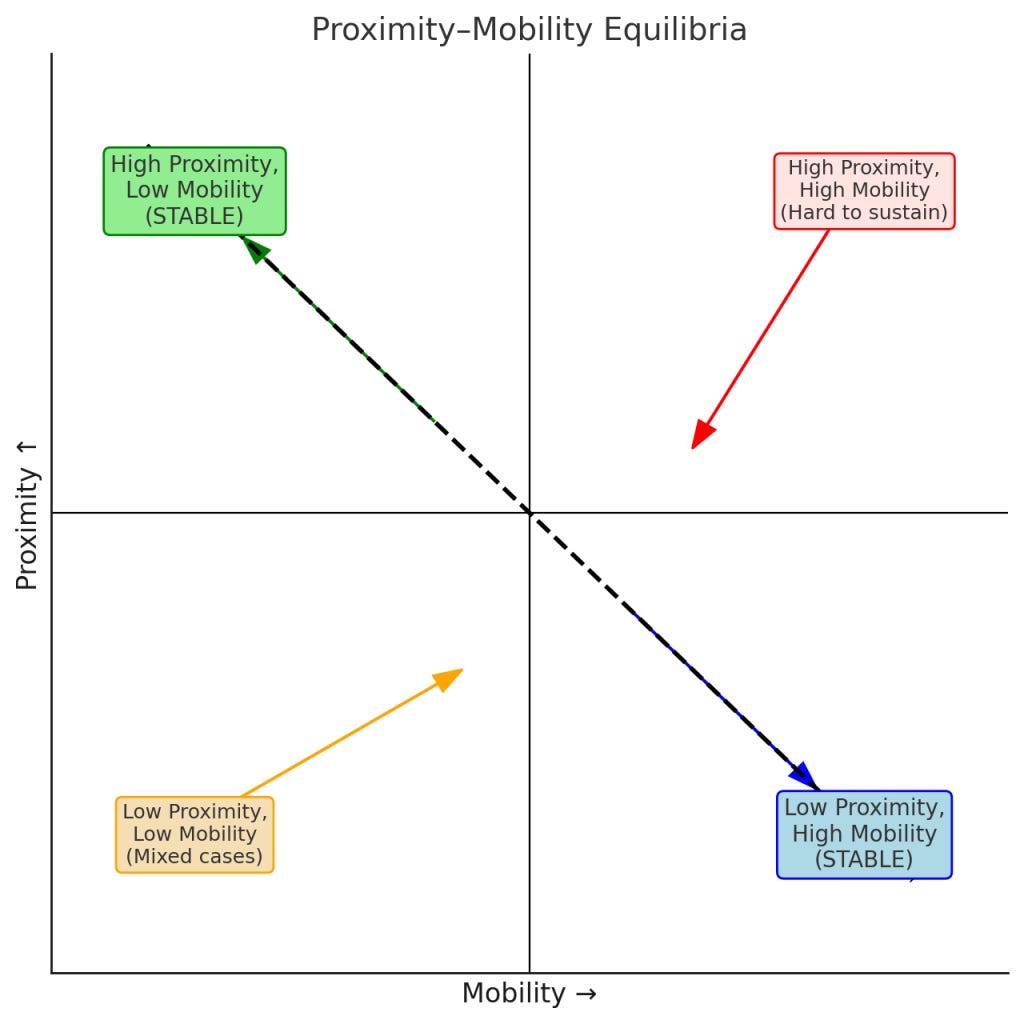Proximity is the Enemy of Mobility (and Mobility is the Enemy of Proximity)
Proximity, how near things are to each other, doesn’t just substitute for mobility, how quickly we can move on the network across space, it undermines it. Higher density slows people and vehicles down. Narrower streets, more intersections, more stations, more people crossing all reduce speed.
Mobility, in turn, undermines proximity. The faster and farther people can travel, the more spread out development becomes. High mobility makes low density possible, and in practice it induces it. Developers follow the roads and rails outward. That lowers the chance of dense, walkable centres forming in the first place.
We cannot optimise both proximity and mobility. Proximity and Mobility cannot be friends. We settle into one of two worlds.
High proximity, low mobility: dense, mixed places where most needs are close. Speeds are low by design and by crowding, so the marginal value of extra speed is small.
High mobility, low proximity: spread-out places where most needs are far. Speeds must be high to make life work, so the marginal value of extra proximity is small.
These are each attractors. Each reinforces itself.
The result is a lock-in. Proximity cancels out mobility; mobility cancels out proximity. The fight is over which path dominates.
If mobility and proximity are enemies, then the only way forward is to stop treating them as independent goals. The goal is access, the product of the two: Accessibility=f(Proximity,Mobility), it increases with both.
If we keep chasing mobility (congestion-busting) for its own sake, we’ll spread ourselves thin, and proximity will wither. If we chase proximity alone, we risk isolation. The most successful cities historically valued proximity more, and CBDs were dense and walkable. This is still true in places like Shenzhen (which is at least dense). More modern western cities (Phoenix, Vegas, Silicon Valley, Canberra, Perth) have chosen to prioritise mobility, and speeds have increased while densities fall, and efforts to transform one city type to another have fallen flat, as each typology is sticky, and urban form locks in. Choose your fighter.
Selected References
Bruno, Campanelli et al. paper “The dimensions of accessibility: proximity, opportunities, values” (arXiv:2509.11875) https://arxiv.org/pdf/2509.11875
Levine, Jonathan; Grengs, Joe; Shen, Qingyun; Shen, Qing (2012). “Does Accessibility Require Density or Speed? A Comparison of Fast Versus Close in Getting Where You Want to Go in U.S. Metropolitan Regions.” Journal of the American Planning Association, Vol. 78, No. 2, pp. 157-172. DOI:
Levine, Jonathan; Grengs, Joe; Merlin, Louis A. (2019). From Mobility to Accessibility: Transforming Urban Transportation and Land-Use Planning. Cornell University Press. DOI:
Grengs, Joe; Levine, Jonathan; Shen, Qing; Shen, Qingyun. (2010). “Intermetropolitan Comparison of Transportation Accessibility: Sorting out Mobility and Proximity in San Francisco and Washington, D.C.” Journal of Planning Education and Research, Vol. 29, No. 4, pp. 427-443. DOI:


